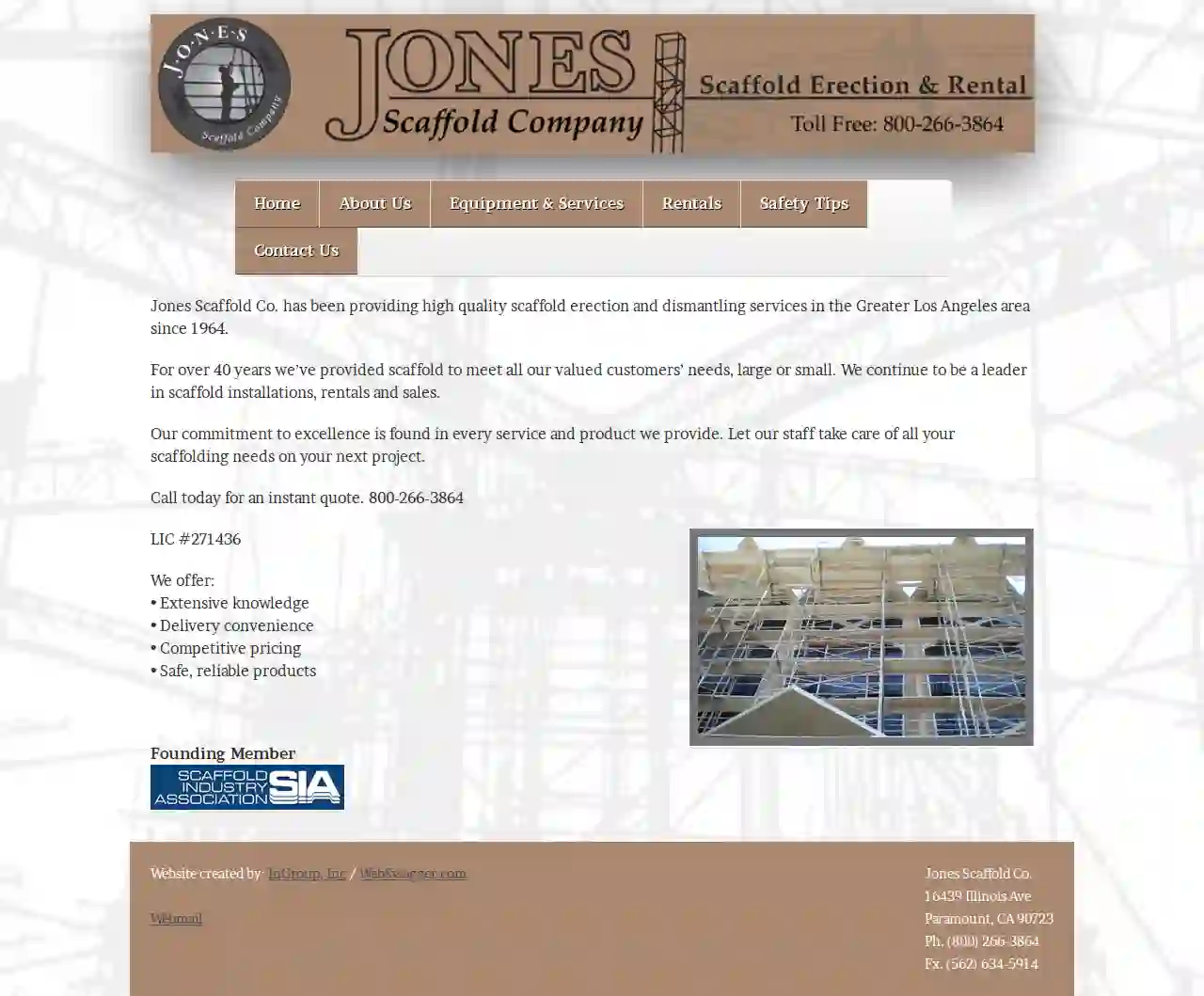Scaffolding Companies Alum Rock
Find Scaffolding Companies in Alum Rock
Get 3 FREE Scaffold Services quotes for your project today! Compare profiles, reviews, accreditations, portfolio, etc... and choose the best offer.

Jones Scaffold Co
3.25 reviews16439 Illinois Ave, Paramount, 90723, USJones Scaffold Co. has been providing high quality scaffold erection and dismantling services in the Greater Los Angeles area since 1964. For over 40 years we’ve provided scaffold to meet all our valued customers’ needs, large or small. We continue to be a leader in scaffold installations, rentals and sales. Our commitment to excellence is found in every service and product we provide. Let our staff take care of all your scaffolding needs on your next project. Call today for an instant quote. 800-266-3864 LIC #271436 We offer: Extensive knowledge Delivery convenience Competitive pricing Safe, reliable products Founding Member
- Services
- Why Us?
- Gallery
Get Quote
INTEGRATED SCAFFOLDING CONCEPTS
54 reviews11924 Old Stage Road, Chester, 23836, USAt Integrated Scaffolding Concepts, we're your trusted partner in scaffolding excellence since 2015. Our seasoned team of professionals is unwavering in its commitment to delivering the pinnacle of scaffolding solutions tailored to your specific project requirements. We offer more than just scaffolding; we provide a solid foundation for your ambitions. Our adept engineers can craft a scaffold system that harmonizes seamlessly with the most demanding environments, ensuring a secure and reliable working platform for all your access needs. Our ethos revolves around a dual commitment: functionality and safety. These are paramount considerations not only during the setup phase but throughout the entire lifecycle of your project. We recognize that scaffolding is an indispensable asset, integral to every facet of your undertaking. Discover how ISC can elevate your scaffolding experience, setting a new standard for excellence and safety in your projects. Trust in our expertise and let us be your scaffolding partner of choice.
- Services
- Why Us?
- Our Team
- Gallery
Get Quote
Elite Scaffold LLC
4.822 reviewsOakland, USAt Elite Scaffold, we are fully devoted to providing the best access solutions in Northern California. As a family operated business, we work by our values of safety, reliability and communication. With 25+ years of experience, we know these values lead to flawless execution of every project, every time. Our number one priority is protecting our clients, workers and the surrounding community. We have an impeccable safety record and are fully committed to keeping it this way. That’s why our elite team of riggers is highly trained in congruence with OSHA regulations. Our steadfast work ethic ensures that every project is done both efficiently and cost-effectively. We emphasize clear and consistent communication, so that our clients and the community have peace of mind every step of the way. We provide elite scaffolding services for your projects, including residential and commercial scaffolding, suspended platforms, access towers, engineered shoring, debris chutes, shrink wrap and netting, and pedestrian canopy.
- Services
- Why Us?
- Accreditations
- Testimonials
- Gallery
Get Quote
Royal Bay Scaffold, LLC
512 reviews4096 Piedmont Avenue Suite#616, Oakland, 94611, USRoyal Bay Scaffold is a scaffolding rental and services company based in Oakland, California. We provide superior scaffold solutions, reliable services, and competitive pricing. Our team members have 14 years of experience in the industry, and our company was established in 2017. We offer a range of services, including erecting and dismantling scaffold, pedestrian walkways, netting/mesh, and system & walk-thru frames scaffolds. We service all trades and are committed to safety, with a focus on OSHA safety rules and regulations. At Royal Bay Scaffold, we take pride in providing quality and safety services. We understand the importance of safety in the workplace and strive to maintain our reputation as skilled scaffolders. Our team members are dedicated to providing excellent service and ensuring that our clients' projects are completed safely and efficiently.
- Services
- Why Us?
- Accreditations
- Gallery
Get Quote
Scaffolding Los Angeles
53 reviews123 Scaffolding Lane, Los Angeles, CA, 90001, USScaffolding Los Angeles is the leading Los Angeles and Southern California supplier of the highest quality scaffolding. With over 20 years of experience and professionalism, we offer a complete range of services, including rental and sales to erecting and dismantling. Our goal is to help your team succeed in their work. We are committed to producing results of the highest quality and have the highest commitment to safety. We supply top of the line products and follow OSHA standards to allow you to handle your work safely.
- Services
- Why Us?
- Accreditations
- Our Team
- Testimonials
- Gallery
Get Quote
Steel City Scaffold
1234 Main St, Los Angeles, CA, 90001, USSteel City Scaffold, Inc. is a commercial and industrial scaffold company specializing in providing top-notch scaffolding solutions to clients in Central and Southern California. With a focus on safety, quality, and excellence, Steel City Scaffold offers a wide range of scaffolding accessories including Canopy, Stair Towers, Re-shoring, Handrailing, Trash Chutes, and more. As a member of the SAIA since 2010, Steel City Scaffold understands the importance of setting safe scaffolding and offers 'Scaffold Awareness Training' to ensure users working on scaffolding understand and recognize safety hazards. Steel City Scaffold, Inc. is committed to providing immediate response, quick turnaround, and excellent customer service.
- Services
- Why Us?
- Accreditations
- Our Team
- Testimonials
- Gallery
Get Quote
Commercial Scaffolding of California, Inc.
4.813 reviewsLos Angeles, USCommercial Scaffolding, Inc. (CSI) is a leading scaffolding company in California and Nevada, providing safe, honest, and immediate service since 1999. With offices in Los Angeles, Northern California, San Diego, and Las Vegas, CSI offers a range of services including commercial, residential, and industrial scaffolding and shoring installation, safety training, equipment sales, and shoring rentals. The company is a union signatory, dedicated to helping clients achieve their project goals.
- Services
- Why Us?
- Gallery
Get Quote
Power Scaffold Service
4.52 reviews157 East Terrance Way, Bakersfield, 93307, USAt Power Scaffold Services, we build long-lasting relationships with our clients by working closely with them to understand and anticipate their needs. We provide cost-effective solutions that enable our clients to complete their projects safely, on-time, and according to plan. Our top-notch, versatile team has erected and dismantled scaffolds for hospitals, theaters, restaurants, oil refineries, power plants, chemical plants, cement plants, and water treatment plants using our state of the art, long-lasting, and durable Cup-Lock Scaffold System.
- Services
- Why Us?
- Accreditations
- Gallery
Get Quote
Ready Equipment Rental Inc.
421 reviews3969 N Sierra Way, San Bernardino, 92405, USAt Ready Equipment Rental, we have been providing our customers in the greater San Bernardino - Riverside Counties with an extensive variety of quality equipment rentals and tool rentals since 1988. From floor sanders to tile saws, utility trailers to tillers, tractors and bobcats to pressure washer's, we have the rental equipment and tools you need to build, maintain, power, move, or clean your projects. We are family owned, conveniently located at 3969 N Sierra Way, in San Bernardino Just north of the 210 Freeway and Waterman ave. We are here to help anyway we can for all your equipment rental and tool rental needs. Ask us about our affordable delivery and pickup, new and used equipment for sale.
- Services
- Why Us?
- Gallery
Get Quote
Contractors Scaffold Supply
4.84 reviews229 Harbor Way, South San Francisco, 94080-6811, USWelcome to Contractor's Scaffold Supply, Inc. Contractors Scaffold is a family owned company serving the greater San Francisco Bay Area, providing stationary scaffolding for residential and commercial use. We provide rental solutions for new or existing structures, drawing on our extensive knowledge and experience. Many of our crew members possess 10-15 years of experience in the field. Contractor's Scaffold can furnish, erect, and dismantle full scaffolding for our customers. You can relax knowing your scaffolding will be erected properly, safely, on-time, and in compliance with OSHA regulations. We also offer scaffolding components "rental or purchase" for customers who prefer to perform their own installations. Contractors Scaffold is also proud to have designed and patented a new safer All Thread Anchor Clamp. Find out more
- Services
- Why Us?
- Our Team
- Testimonials
- Gallery
Get Quote
Over 2,353+ Scaffolding Companies onboarded
Our scaffolding experts operate in Alum Rock & surroundings!
ScaffoldingHQ has curated and vetted Top Scaffolding Companies in and around Alum Rock. Find the most reliable pro today.
Frequently Asked Questions About Scaffolding Companies
- Encroaches onto public property (sidewalks, roads): Permits are usually needed from the local council or highway authority.
- Exceeds a certain height: Scaffolding above a specified height often requires a permit.
- Is erected in a conservation area or near a listed building: Special considerations and permits may apply.
- A larger, more complex structure typically used for accessing multiple levels of a building.
- Offers greater height and versatility.
- Often used for construction, renovation, and maintenance.
- Smaller, portable platforms usually used for tasks at a single level.
- Commonly used for painting, plastering, or light repairs.
- Can be rolling or stationary.
Can I erect scaffolding myself?
Do I need a permit for scaffolding in the USA?
What is the difference between scaffolding and staging?
Scaffolding:
What is a scaffolding hoist?
Can I erect scaffolding myself?
Do I need a permit for scaffolding in the USA?
- Encroaches onto public property (sidewalks, roads): Permits are usually needed from the local council or highway authority.
- Exceeds a certain height: Scaffolding above a specified height often requires a permit.
- Is erected in a conservation area or near a listed building: Special considerations and permits may apply.
What is the difference between scaffolding and staging?
Scaffolding:
- A larger, more complex structure typically used for accessing multiple levels of a building.
- Offers greater height and versatility.
- Often used for construction, renovation, and maintenance.
- Smaller, portable platforms usually used for tasks at a single level.
- Commonly used for painting, plastering, or light repairs.
- Can be rolling or stationary.